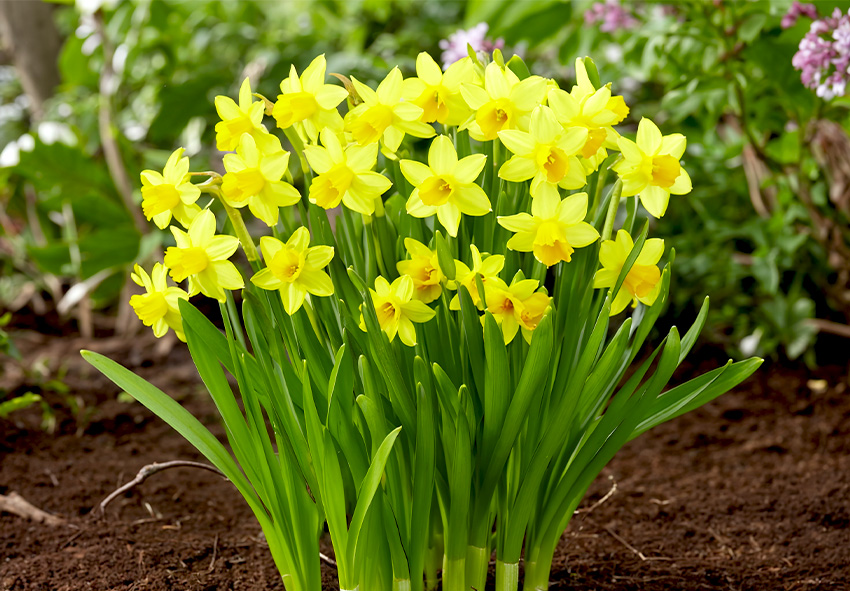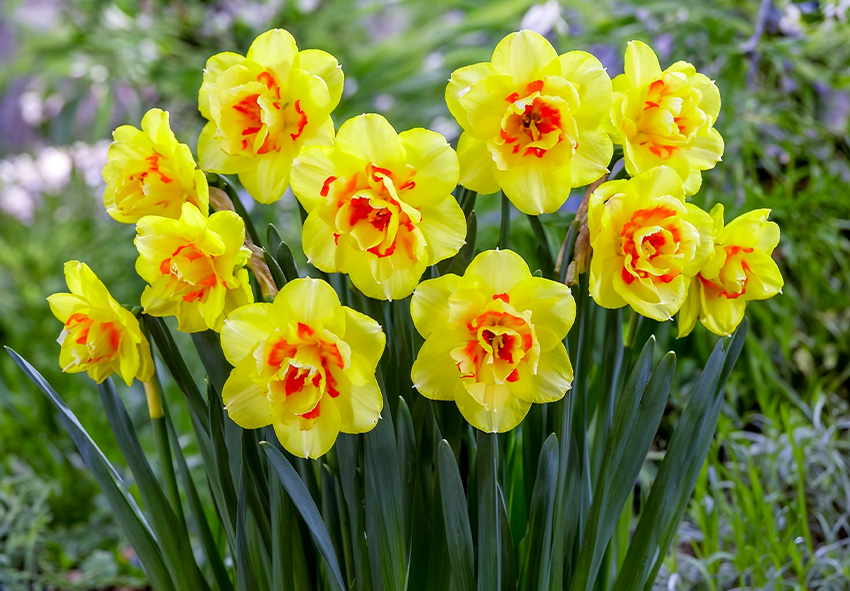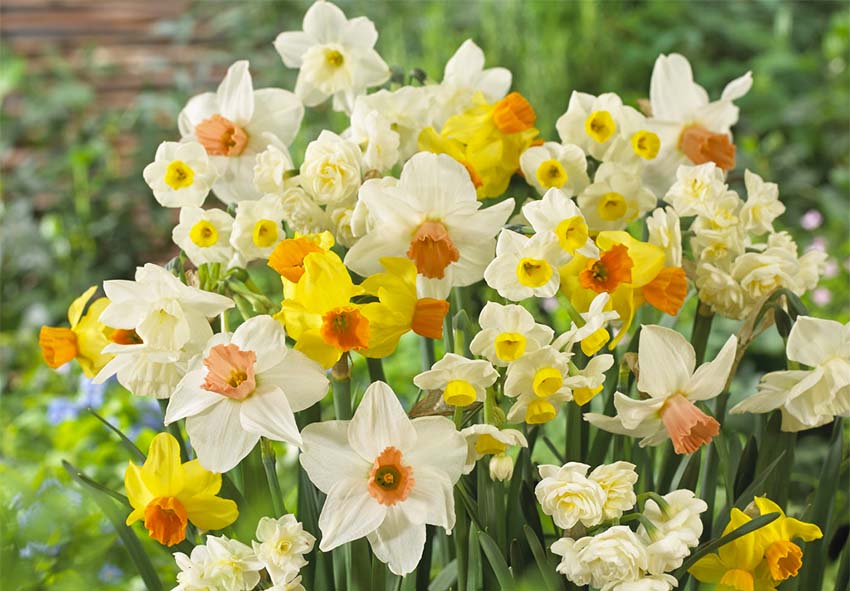Daffodils are among the most beloved spring flowering bulbs, brightening gardens with cheerful shades of yellow, white, and even orange. Known for their reliability and ease of care, these hardy perennials return year after year, offering a spectacular display after the long winter months. Whether you prefer traditional trumpet daffodils or unique double varieties, there’s a daffodil type to suit every garden style. Our gardening blog is a perfect place to find all the information about daffodils and other plants you need.
Why Grow Daffodils in Your Garden?

Daffodils are more than just pretty flowers — they are symbols of renewal and the arrival of spring. These hardy perennials thrive in a wide range of conditions, making them a must-have for both beginner and experienced gardeners. With dozens of daffodil varieties available, they offer unmatched diversity and charm for every garden. And here is why:
- Timeless spring charm: Few flowers are as synonymous with spring as daffodils. Their cheerful blooms symbolize new beginnings and bring a burst of color when most plants are still dormant. Adding daffodils ensures your garden welcomes spring with a flourish of brightness.
- Easy to grow and care for: Daffodils are one of the easiest spring bulbs to grow, making them perfect for beginners and seasoned gardeners alike. Once planted in autumn, they require minimal maintenance and thrive in a wide range of soils. Their natural pest resistance also makes them a low-risk choice.
- Perfect for borders, containers, and naturalizing: These versatile flowers can be grown in flower beds, borders, pots, or naturalized in lawns and woodlands. With varieties ranging from tall trumpets to miniature daffodils, they adapt beautifully to any landscape design. Their long-lasting blooms make them equally useful for cut flower arrangements.
Top 10 Popular Daffodil Varieties
With so many daffodil types available, it can be hard to choose which ones to grow. From traditional trumpet daffodils to fragrant doubles and delicate white varieties, there is a bloom for every taste. Below are ten of the most popular daffodil varieties that gardeners love worldwide.
Dutch Master
Dutch Master is one of the most popular daffodil varieties and a true classic. Its large, golden-yellow trumpets bloom in mid-spring and stand tall on sturdy stems. This variety is excellent for mass plantings or as a focal point in borders.
Tête-à-Tête
This miniature daffodil variety is famous for its compact size and abundance of blooms. Tête-à-Tête flowers early in the season, making it a favorite for containers and window boxes. Its bright yellow blooms provide a cheerful welcome to spring.
February Gold
True to its name, February Gold is one of the earliest daffodils to bloom. Its slim golden trumpets and narrow petals bring brightness to late winter landscapes. This variety is ideal for naturalizing in meadows or woodland edges.
Yellow River
Yellow River is a bold trumpet daffodil with rich golden-yellow petals and a robust presence in the garden. It flowers in mid-spring and pairs beautifully with other spring bulbs like tulips or hyacinths. Its strong stems make it suitable for both borders and cut flowers.
Ice Follies
Ice Follies is a large-cupped daffodil with creamy white petals and a soft yellow center that fades to white as it matures. It blooms early to mid-spring and is perfect for naturalizing in large drifts. Its elegant coloring also makes it a favorite for floral arrangements.
Tahiti

Tahiti is a striking double daffodil with layers of golden petals highlighted by fiery red-orange centers. It blooms in mid-spring and adds a dramatic touch to gardens. With strong stems, it holds up well in borders and cut flower arrangements.
King Alfred
Once considered the gold standard for trumpet daffodils, King Alfred remains a beloved variety. Its bold golden blooms stand out in any garden and make an excellent choice for spring displays. This heritage daffodil still carries charm and history.
White Lion
White Lion is a double-flowering daffodil with creamy white outer petals and soft yellow inner tones. Blooming in mid-spring, it offers a luxurious, rose-like appearance. Its unique look adds sophistication to borders and bouquets.
Thalia
Thalia is an elegant white daffodil with multiple blooms per stem. Its pure white petals and delicate form make it perfect for woodland gardens and naturalized plantings. Known for its subtle fragrance, it’s also an excellent cut flower.
Sun Disc
Sun Disc is a charming miniature daffodil with rounded, flat-faced blooms in a soft yellow shade. It blooms late in the season, extending the daffodil display well into spring. Its compact size makes it an excellent choice for containers and rock gardens.
Tips for Planting and Caring for Daffodils
Growing daffodils successfully starts with proper planting and care. If you’re wondering how to plant daffodils, just check out our beginner-friendly guide. These bulbs are forgiving, but a few careful steps ensure healthy growth and abundant blooms. From planting time to after-bloom care, here’s how to get the best from your daffodils:
- Best time to plant bulbs: The ideal time to plant daffodil bulbs is in autumn, before the ground freezes. Planting in this season allows the bulbs to establish roots before winter, ensuring strong growth and blooms in spring.
- Soil preparation and sunlight needs: Daffodils thrive in well-drained soil enriched with organic matter. They prefer full sun but will also tolerate partial shade. Good drainage is essential, as bulbs left in soggy soil may rot.
- Watering and fertilizing tips: After planting, water the bulbs thoroughly to help them settle into the soil. During spring growth, daffodils appreciate regular watering, especially in dry periods. A balanced bulb fertilizer applied after flowering helps the bulbs store energy for the next season.
- After-bloom care for next season: Once the flowers fade, avoid cutting back the foliage until it has yellowed naturally. The leaves photosynthesize, providing the bulbs with energy for next year’s blooms. Deadhead spent flowers to prevent seed formation and encourage bulb strength.
How to Use Daffodils in Garden Design

Daffodils aren’t just background flowers — they can be design features in their own right. Their bright colors and varied forms make them versatile additions to any garden layout. Whether you prefer borders, containers, or naturalized meadows, daffodils can play a starring role.
Creating vibrant spring borders
Planting daffodils in borders ensures a lively start to spring. Combine tall trumpet daffodils like Dutch Master with tulips and hyacinths for a layered effect. Grouping bulbs in clusters enhances visual impact.
Growing daffodils in containers
Miniature daffodil varieties, such as Tête-à-Tête or Sun Disc, thrive in pots and window boxes. Pair them with early pansies or primroses for a cheerful display. Containers can also be moved to highlight blooms at their peak.
Naturalizing daffodils in lawns and meadows
For a natural look, scatter daffodil bulbs in grassy areas or under trees. Varieties like February Gold and Ice Follies work especially well for naturalizing. Over time, these bulbs multiply, creating a meadow-like sea of spring color.
Conclusion
Daffodils remain one of the most rewarding spring bulbs, offering a dazzling variety of shapes, sizes, and colors. With proper care, these perennials return year after year, bringing cheer to every corner of the garden. By mixing different daffodil varieties, you can enjoy a continuous and diverse display of blooms all season long!
Frequently Asked Questions (FAQs) about Daffodil Varieties
1. What are the most popular daffodil varieties?
Some of the most popular daffodil varieties include Dutch Master, Tête-à-Tête, Tahiti, February Gold, and Yellow River. Gardeners also love Ice Follies, King Alfred, White Lion, Thalia, and Sun Disc. These varieties differ in size, shape, and color, giving you plenty of choices to create vibrant spring displays in your garden.
2. When is the best time to plant daffodil bulbs?
The best time to plant daffodil bulbs is in autumn, usually between September and November, before the ground freezes. Planting during this period allows the bulbs to develop strong roots before winter. This preparation ensures healthy growth and abundant blooms when spring arrives, filling your garden with cheerful flowers.
3. Can I order Holland daffodils in your online store?
Yes! You can order daffodils from our online store Dutch-bulbs.com. We offer a wide variety of daffodil bulbs, including classic yellow varieties, fragrant types, and even unique color variations. Ordering online is convenient and allows you to browse through different options, select your preferred varieties, and have them delivered directly to your doorstep.
4. Can daffodils grow well in containers?
Yes, daffodils grow beautifully in containers, especially smaller varieties like Tête-à-Tête or Sun Disc. Choose a well-draining potting mix and ensure the container has drainage holes to prevent rot. Place pots in a sunny spot and water regularly during growth. Container daffodils can brighten patios, balconies, and entryways with vibrant spring color.
5. Do daffodils come back every year?
Yes, daffodils are perennial bulbs, meaning they return year after year with proper care. Once established, they often multiply, producing larger clumps of flowers over time. To keep them healthy, plant in well-drained soil, allow foliage to die back naturally, and avoid overwatering. With minimal effort, daffodils reliably brighten gardens each spring.
Published: 26.09.2025
